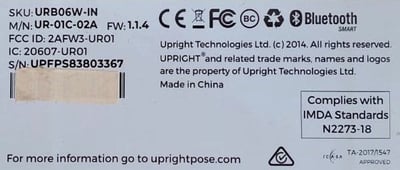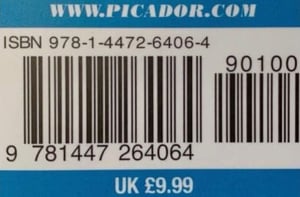
Both retailers and manufacturers will no doubt be familiar with SKUs and their role within the supply chain and buying process.
What is a SKU?
A Stock Keeping Unit (SKU) is a unique set of numbers and letters used to identify, locate and track a product internally in a company or store's warehouse.
These codes are often displayed on a variety of platforms and printed materials, including product pages on a website app or marketplace, as well as on product packaging and user guides.
The below example of a SKU for an electronics product label reads "URB06W-IN".

How long is a SKU number?
Unlike a number of other important codes in product management, SKUs are generated by each company or vendor and unique to that business. With every product release, a new SKU is required by the seller. This can mean that sellers typically have SKU catalogs of thousands of products, all of which might be required to market and sell on a variety of channels.
With that in mind, it’s worth considering how to streamline your processes and optimize your product management with Sales Layer.
Why are SKUs important?
By providing a unique piece of information for each product, SKUs help to ensure simple and correct identification throughout the production chain, inventory tracking and sales.
Product SKUs also have their importance for logistics in addition. The code assists with the identification and classification of each product by color, price, brand, size, size, manufacturer, etc. The combination and order of letters and numbers often depends on the priorities of each seller, in turn often influenced by the buyer’s requirements and the company’s goals.
For example, in a furniture catalog, if customers usually query measurement data, logically that information should appear in the SKU and be placed near the beginning.
The product information, summarized alphanumerically, in SKUs should always be sorted from most to least important and include only the most necessary data, to avoid ending up with SKUs that are too long and inconvenient.
What are the differences between SKU, UPC and EAN?
While the SKU is a code that’s established by each seller, there are other identification codes designed to categorize the product according to global requirements. The characteristics that differentiate UPC and EAN codes from SKUs are as follows:
EAN (European Article Number) or IAN (International Article Number)
- Barcode for scanning
- Numeric only (usually 13 digits)
- The first 3 digits identify the company’s country
- The next 4 or 5 digits identify the owner of the brand
- The remaining digits are the product code
- Includes a check digit

UPC (Universal Product Code)
- Comprises 12 digits
- Numeric only
- Represents product and manufacturer information
- Universal
To give an example, Converse sneakers have a unique and universal UPC barcode which is the same for all stores in all countries around the world. But each seller or store that has these Converse shoes in their catalog can further categorise them in their inventory by a unique SKU number.
SKU (Stock Keeping Unit)
- Variable in length between 8 and 12 characters
- Alphanumeric
- Usually begins with a letter
- Zeros are best avoided
- Represents product information
- Unique for each company
→ This may interest you: 7 common online inventory problems (and solutions)
Advantages of SKUs for your ecommerce business
SKUs are valuable components of product catalog management, offering the follow benefits:
- Optimization of your product catalogs
- Inventory tracking
- Analysis of sales levels and trends
- Application of buyer behavior analytics
- Increase in productivity: Automation in real-time enables quicker responses
- Greater inventory flexibility according to demand
- Maintenance of stock levels of most in-demand products
How to generate SKUs to suit your business
When designing the architecture of your product SKUs, it’s important to identify and determine what information needs to be included within the code. The make-up of your SKU should be relevant to the needs, sales priorities and customer profile of your company.
When creating your new SKUs, we advise following these essential steps:
Catalog organisation and volume
Different businesses will have different requirements when generating SKUs for their product catalogs. For some, it may be important to identify the color of the item, for other the customer type may be more significant e.g women, men, children
The volume of stock your company handles also influences whether your product SKUs should be more detailed or less so. If you carry a lot of stock, the more specific your SKU will need to be to successfully identify and locate each product.
Unique, non-duplicated SKU numbers
You should avoid duplicating a SKU within your own catalog; this is essential for ensuring good inventory tracking and to provide your customer with the correct information at all times.
Even if a product has been removed from the catalog, try not to re-use old SKUs as this may cause identification problems or shipping errors. With a PIM system, you can analyze your SKU catalogs to identify and resolve any duplicate SKUs.
→ This may interest you: Step-by-step guide to designing a product catalog
Uses of SKU in retail: speed, predictability and efficiency
The usefulness of SKUs is mainly internal, as it allows for more accurate inventory tracking, and has a positive impact on other business areas:
Product tracking
A good SKU architecture will ensure that each product is classified following an internal logic system. The item will therefore be easier to locate and to associate with other catalog management data, such as stock levels, manufacturer or supplier information, shipments and orders, and/or sales forecasts.
Scanning the status and activity of each SKU will make it easier to determine the sales rate for each product and to know when more stock will need ordering, or to identify any stagnant stock. When implemented correctly, your warehouse can avoid reaching critical levels or accumulating products that aren’t profitable.
Sales forecasting and catalog reinforcement
By using company-specific barcodes for each product you can analyze the volume and progression over time of both demand and sales more efficiently, and thereby make more informed decisions.
Analyzing the costs and revenues associated with each SKU number also allows you to quickly identify which products are performing better or worse.
Sales Layer’s Product Information Manager (PIM) centralizes and automates each product’s information such as SKUs and GTIN numbers, and as such can assist with catalogs of all sizes.
Improved customer service
SKUs enable both customer service teams and employees at your physical stores to quickly locate each product and query.
Using SKUs makes it more efficient for you to find a product, repeat a previous order, recommend similar products and compare product features. For this reason SKU codes allow you to quickly locate the product a customer is looking for, view its current stock level and offer alternatives should the desired item be out of stock.
Of course, this kind of help is just as important in brick-and-mortar stores, where sales assistants can immediately answer questions about stock without having to visit the warehouse nor trawl the shelves by hand. In addition, it benefits the design and layout of physical stores, as it enables you to reduce the exhibited stock to just one item per category.
→ This may interest you: How product information can improve customer support
Whether you're a retailer or manufacturer, managing your product SKU catalogs with PIM software such as Sales Layer can not only save you time on your processes, but increase revenue and provide a better product experience.
Get started with our free 30-day trial and find our just how our PIM software can help your business.
Alternatively, one of our in-house experts can assist you with a helpful demo of our software.




.jpg)
-1.webp?width=520&name=formulas-excel-gestion-inventario%20(1)-1.webp)



